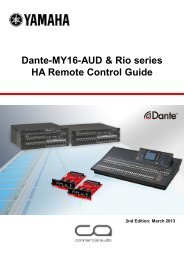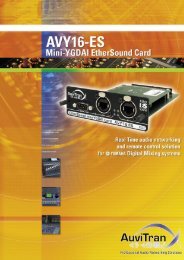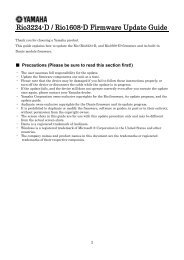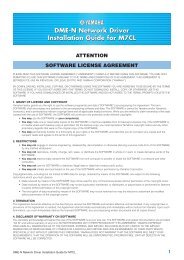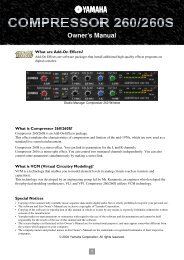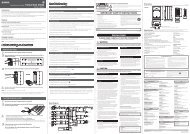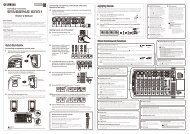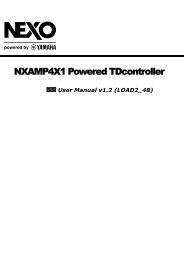Yamaha Digital Audio System Design Guide 8.42MB
Yamaha Digital Audio System Design Guide 8.42MB
Yamaha Digital Audio System Design Guide 8.42MB
Create successful ePaper yourself
Turn your PDF publications into a flip-book with our unique Google optimized e-Paper software.
<strong>Digital</strong> <strong>Audio</strong> Transmission and<br />
Differences between Analog <strong>Audio</strong> and<br />
<strong>Audio</strong> Networks<br />
Whenever transferring multiple channels of audio in analog format,<br />
the devices used for transmission and reception are connected using<br />
thick analog multicore cables. As a cable is required for each channel<br />
being used, the multicore cables comprising all of the necessary<br />
wires can become extremely heavy; in addition, they require<br />
considerable physical effort to handle, and a signifi cant amount of<br />
time and money is needed for their setup and installation.<br />
<strong>Digital</strong>-audio transmission technologies as typifi ed by the AES/<br />
EBU standard convert analog audio into digital signals and have<br />
the advantage of being able to transfer these digital signals with<br />
extremely low levels of audio deterioration. That said, however, they<br />
cannot be said to offer signifi cant advantage in terms of transmittable<br />
channel numbers, bi-directionality, and the like.<br />
Network audio, on the other hand, is an audio transmission format<br />
that makes use of PC network technologies such as Ethernet.<br />
Network audio systems are capable of long-distance, multi-channel,<br />
bidirectional transmission, and they also allow complicated routing<br />
patterns to be confi gured within networks. As a result of the rapid<br />
pace of advancement in digital communication technologies in recent<br />
years, the principal network audio formats in use today can handle<br />
several dozen channels on network-audio cables of, for example,<br />
the Cat5 design, while formats supporting optical- fi ber cables have<br />
an even greater capacity and are capable of transmitting several<br />
hundred channels.<br />
As Cat5, optical-fi ber, and other digital cables can transfer a number<br />
of audio channels that far exceeds that of a single analog multicable,<br />
they offer a major advantage in terms of installation cost and setup<br />
time. Transmission distance also can be extended much further<br />
than before with practically no deterioration in signal quality, and<br />
therefore, digital audio networks offer an overwhelming performance<br />
advantage over analog lines in PA, sound reinforcement, relay<br />
broadcasting, and many other applications. In digital audio networks,<br />
furthermore, input and output channels can be freely setup on<br />
an individual device basis, allowing highly-fl exible systems to be<br />
realized. And since control signals can also be transmitted together<br />
with audio signals, these networks facilitate the setup of advanced,<br />
16-channel analog multicable<br />
Up to 16 channels of audio<br />
Transmission distance: Up to 120 m<br />
Cat5 cable<br />
64-in / 64-out audio channels<br />
Control signals<br />
Transmission distance: 100 m<br />
highly convenient operating environments where, for example, head<br />
amps located a signifi cant distance away from the mixer can be<br />
remotely controlled and the operating status of amp groups can be<br />
monitored.<br />
In order to benefi t from these formidable advantages, applications<br />
that have until now made use of conventional analog lines — for<br />
example, sound reinforcement in live music venues, stadiums, and<br />
theatres; and live broadcasting — are currently undergoing a rapid<br />
change to digital audio networks. Analog lines have traditionally<br />
been seen as the cheaper solution, but digital audio networks are<br />
making inroads here also, and systems such as CobraNet, for<br />
example, also offer cable and switch redundancy as standard. If a<br />
problem were to occur with any of the network's switches or cables,<br />
other cables would be automatically patched in to preserve network<br />
integrity and maintain signal fl ow; consequently, the fl ow of audio<br />
would be completely unaffected and processing could continue as<br />
normal. A range of other network formats making use of advanced,<br />
proprietary technologies in order to further enhance reliability are<br />
also available, and all satisfy the stringent dependability and stability<br />
requirements of the professional environment. Thanks to these<br />
signifi cant advantages, network audio is already providing solutions<br />
in a large number of situations where high-level performance is a<br />
must. And in addition to large-scale installations in many different<br />
countries and world-tour scale concerts here at home, this<br />
technology is also being applied in sound reinforcement, musical<br />
performances, broadcasting, and countless other projects of widely<br />
varying scales.<br />
Advantage of Network <strong>Audio</strong> Signals<br />
Network audio solutions currently suitable for professional<br />
applications all utilize Cat5 or similar cables in order to facilitate<br />
multi-channel transmission of several dozen channels. If also<br />
using optical-fi ber cables, furthermore, dramatic increases can be<br />
achieved in terms of channel numbers and transmission distance.<br />
With analog lines, the longer the transmission distance, the greater<br />
the level of interference due to external noise, making signal<br />
deterioration unavoidable. With network audio, on the other hand,<br />
sound signals are converted into digital format, which in theory,<br />
suffers from absolutely no interference due to external noise. In other<br />
Optical-fiber cable<br />
Ex: Duplex SC type<br />
Several hundred audio channels<br />
Video signals<br />
Control signals<br />
Transmission distance: 2 km over (single mode)<br />
Networks<br />
words, this technology facilitates high-quality transmission of multichannel<br />
audio, regardless of the transmission distance.<br />
<strong>Digital</strong> <strong>Audio</strong> Networks and Cost<br />
Performance<br />
Requiring an individual circuit for each audio channel, standard<br />
analog multicables are extremely heavy and expensive. For example,<br />
a cable of this type with capacity for sixteen channels would weigh<br />
approximately 53 kg per 100 meters, whereas in contrast, the weight<br />
of a Cat5 cable per 100 meters is a mere 6 kg or thereabouts.<br />
Meanwhile, a two-core optical-fi ber cable is also much lighter, at<br />
only about 11 kg for the same length. A professional setup using,<br />
for example, 128 input channels and 32 output channels would<br />
typically require a total of ten analog multicables, each handling<br />
16 channels; however, if a network audio solution were used, the<br />
same performance level could be achieved with two Cat5 cables<br />
or a single optical-fi ber cable. And since this difference in weight<br />
and cost becomes more and more pronounced as the transmission<br />
distance grows, the advantage offered by network audio solutions<br />
over analog audio is beyond doubt.<br />
In analog audio installations, furthermore, cables must often be<br />
laid and connected in complicated patterns in order to match<br />
system diagrams; however, as the fl ow of audio signals can be<br />
easily controlled using software with many network-audio formats,<br />
the same systems can be realized with but a handful of physical<br />
connections. In this type of case, therefore, not only is it possible<br />
to achieve remarkable savings in terms of time and effort, but the<br />
potential for mistakes or problems associated with large amounts of<br />
manual labor can also be sharply reduced. Even after installation,<br />
furthermore, these network audio solutions allow signal routing,<br />
channel numbers, and other system parameters to be modifi ed<br />
and adjusted in a highly fl exible way using the same software, thus<br />
generating massive improvements in the effi ciency and ease of work<br />
associated with system installation and setup.<br />
Left: Optical-Fiber cable, Right: Analog Multi cable<br />
Control Functions<br />
A large number of digital audio networks also facilitate the transmission<br />
of control signals together with multi-channel audio, and as such,<br />
make it possible to create highly-advanced, highly-controllable audio<br />
environments. For example, this type of setup allows networked<br />
devices such as power amplifi ers and remote head amps integrated<br />
into A/D converters to be conveniently monitored and controlled. In<br />
addition, central control and monitoring of groups of devices located<br />
some distance away in amplifi er rooms or equipment rooms can also<br />
be carried out via a PC or digital mixer.<br />
Selecting the Best Network <strong>System</strong><br />
A host of network audio systems with differing formats are currently<br />
available from a wide range of manufacturers. Regardless of<br />
whether a network is to be used with PA and sound-reinforcement<br />
equipment for live performances and concerts or for broadcasting,<br />
the ideal format is normally selected based on a number of different<br />
factors — for example, the size and purpose of the installation site,<br />
the number of channels needed, transmission distances, whether<br />
or not redundancy is required in order to further enhance reliability,<br />
device compatibility requirements, and the level of latency (i.e.,<br />
delay) occurring as a result of audio processing or inherent to the<br />
network system itself.<br />
Once a network format has been chosen in line with the specifi c<br />
advantages that it offers, it is generally possible to combine devices<br />
from multiple manufacturers in order to confi gure the actual network,<br />
as long as they all support the same format. With <strong>Yamaha</strong> professional<br />
audio equipment, however, it is also possible to directly connect<br />
devices compatible with different network-audio formats. More<br />
specifi cally, <strong>Yamaha</strong> products can be fi tted with two or more mini-<br />
YGDAI cards for different network formats in order to also function<br />
as a format converter, thus vastly expanding the range of potential<br />
applications. Thanks to the open architecture concept adopted in the<br />
design and development of these products, our professional audio<br />
equipment can be combined with all types of network-audio format,<br />
and regardless of scale, can also be positioned right at the heart<br />
of these networks. In fact, <strong>Yamaha</strong>'s digital mixers have become<br />
the de-facto standard for this type of central role, which itself is<br />
testament to the ability of these products to support many different<br />
system solutions in order to meet the varying needs of the market.<br />
In addition to superior levels of quality and reliability, therefore,<br />
this represents a further advantage of <strong>Yamaha</strong> professional audio<br />
equipment.<br />
3 <strong>Yamaha</strong> <strong>Digital</strong> <strong>Audio</strong> <strong>System</strong> <strong>Design</strong><br />
<strong>Yamaha</strong> <strong>Digital</strong> <strong>Audio</strong> <strong>System</strong> <strong>Design</strong> 4



